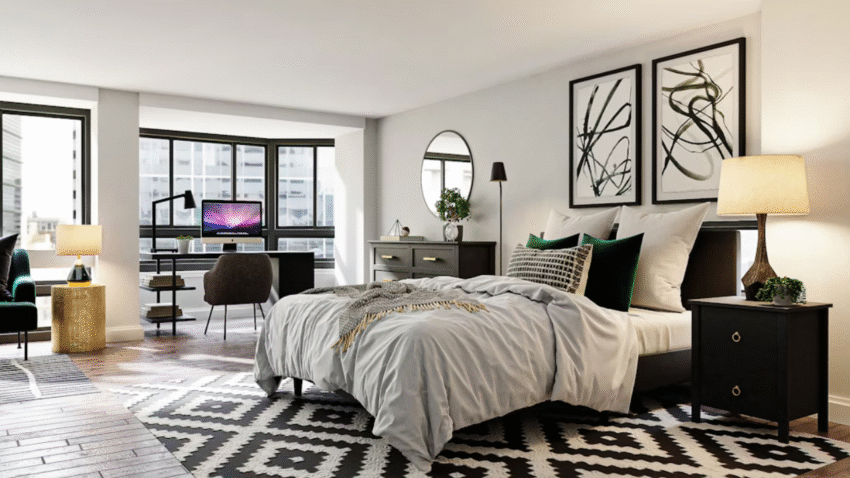Introduction
Ever feel like your bedroom lighting is too harsh, too dim, or just plain awkward? You’re not alone! Knowing how to position lamps for balanced lighting can transform your bedroom from flat and uninviting to cozy and functional. A well-lit room makes everyday tasks easier, sets the mood for rest and relaxation, and shows off your décor beautifully. This step-by-step guide will help you layer and place your lamps like a pro so your bedroom feels warm, balanced, and perfectly lit.
Why Balanced Lighting Matters in the Bedroom
Your bedroom isn’t just for sleeping—it’s a place for reading, relaxing, and sometimes even working. Relying on a single overhead light can create shadows or feel too harsh at night. Layering light sources and positioning lamps correctly ensures that every corner of your room is usable and inviting. Balanced lighting improves your mood, helps your eyes relax, and makes your space feel finished and thoughtfully designed.
Step-by-Step Guide to Positioning Lamps for Balanced Lighting
1. Understand the Three Layers of Lighting
Balanced lighting combines three main types of light:
- Ambient Lighting: The main source of general light—usually a ceiling fixture.
- Task Lighting: Focused light for activities like reading, working, or getting dressed.
- Accent Lighting: Decorative light that highlights features and adds warmth.
For a bedroom, lamps often provide both task and accent lighting. Layering all three makes your lighting more flexible.
2. Start with Bedside Lamps
Bedside lamps are essential for reading or winding down at night.
- Position table lamps or wall-mounted sconces on each side of the bed to create symmetry and balance.
- Place lamps at a height where the bottom of the shade is about level with your chin when sitting up in bed.
- Keep lamps within easy reach for turning on and off without getting up.
3. Use Matching or Coordinated Lamps for a Cohesive Look
You don’t need identical lamps, but they should coordinate.
- For a classic look, use matching bedside lamps.
- For a more eclectic feel, mix different lamp bases but use matching shades or similar heights to keep things balanced.
4. Light Up Your Nightstands Smartly
Your nightstands should be large enough to hold a lamp without feeling crowded.
- Leave room for essentials like books, glasses, or a clock.
- Use lamps with a slim base if your nightstands are small.
- Wall-mounted lamps free up surface space altogether.
5. Balance the Room with Additional Lamps
Don’t stop at the bed! Use other lamps to balance light throughout the room.
- Place a floor lamp in a dark corner to soften shadows and make the space feel larger.
- Use a table lamp on a dresser or vanity for extra task lighting.
- Keep lamp heights varied to create depth and dimension.
6. Position Lamps to Reduce Shadows
Avoid dark spots by considering how light spreads.
- Angle task lamps so they don’t cast shadows on your work or reading area.
- Place lamps away from obstacles like tall furniture that can block light.
- Use multiple lamps in larger rooms to light all four corners evenly.
7. Use Dimmers or Smart Bulbs for Flexibility
Lighting needs change throughout the day.
- Add dimmer switches to bedside lamps for soft, ambient lighting at night.
- Smart bulbs let you adjust brightness and color temperature to suit your mood.
- Warm, low light is ideal for evenings; cooler, brighter light works well for morning tasks.
8. Think About Bulb Types and Shades
How you position lamps is only half the battle—bulbs and shades matter too.
- Use warm white bulbs (2700K–3000K) for a cozy, relaxing vibe.
- Choose shades that diffuse light evenly. Fabric shades create soft light, while metal or dark shades direct light downward for focused tasks.
- Position bulbs so they’re not directly visible when seated or lying in bed to prevent glare.
9. Highlight Décor with Accent Lamps
Accent lighting brings your bedroom’s design to life.
- Use small accent lamps on shelves to spotlight art, plants, or decorative objects.
- Fairy lights or LED strips can add a soft glow behind a headboard or along shelves.
- Avoid overdoing it—one or two accent lights add warmth without feeling cluttered.
Common Mistakes to Avoid
Mistake 1: Using Only an Overhead Light
Solution: Always layer your lighting. Overhead lights alone can feel cold and cast unflattering shadows.
Mistake 2: Placing Lamps at the Wrong Height
Solution: Position lamps so the light hits where you need it—at reading height by the bed or at eye level when sitting at a desk.
Mistake 3: Choosing the Wrong Bulb Brightness
Solution: Use bulbs that are bright enough for tasks but adjustable for relaxing. Aim for 40–60 watts or equivalent in LEDs for bedside lamps.
Mistake 4: Forgetting Dark Corners
Solution: Add a floor lamp or table lamp to any shadowy areas to keep the room balanced.
Mistake 5: Blocking Light Sources
Solution: Place lamps so furniture doesn’t block the light flow. A well-placed lamp should spread light freely across the room.
Extra Tips & Bedroom Hacks
- Try a Plug-In Sconce: Renters can use plug-in wall lamps for bedside lighting without drilling holes for hardwired fixtures.
- Use Smart Plugs: Control all your lamps with a single app or voice assistant for easy lighting adjustments.
- Related Guide: Want to create a more restful space? Read our step-by-step article on how to reduce noise for better sleep in your bedroom for even more bedroom comfort tips.
Conclusion
When you know how to position lamps for balanced lighting, your bedroom instantly feels cozier, more functional, and ready for anything—from reading your favorite book to drifting off peacefully. By layering ambient, task, and accent lighting and placing lamps thoughtfully, you can highlight your décor and create the perfect atmosphere day or night.
Remember: good lighting design is flexible and intentional. Bookmark this guide to keep your bedroom feeling balanced, beautiful, and perfectly lit all year long!
